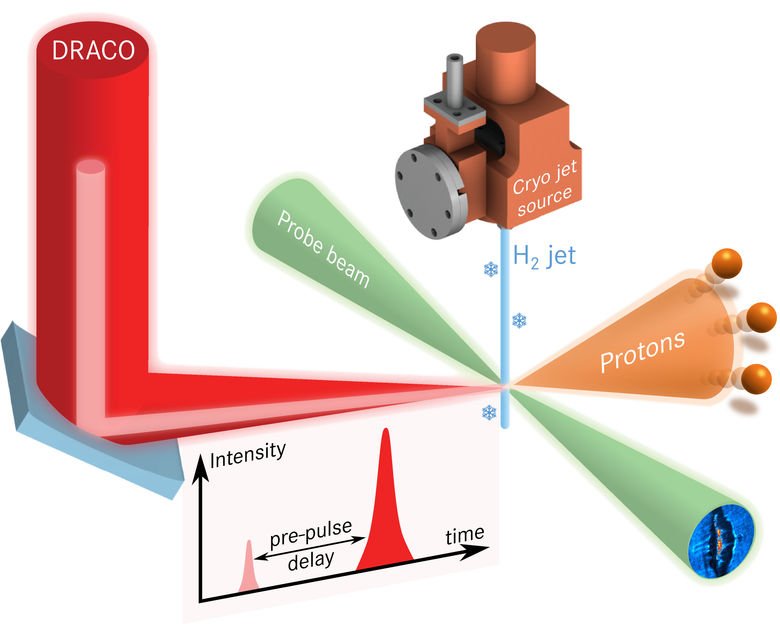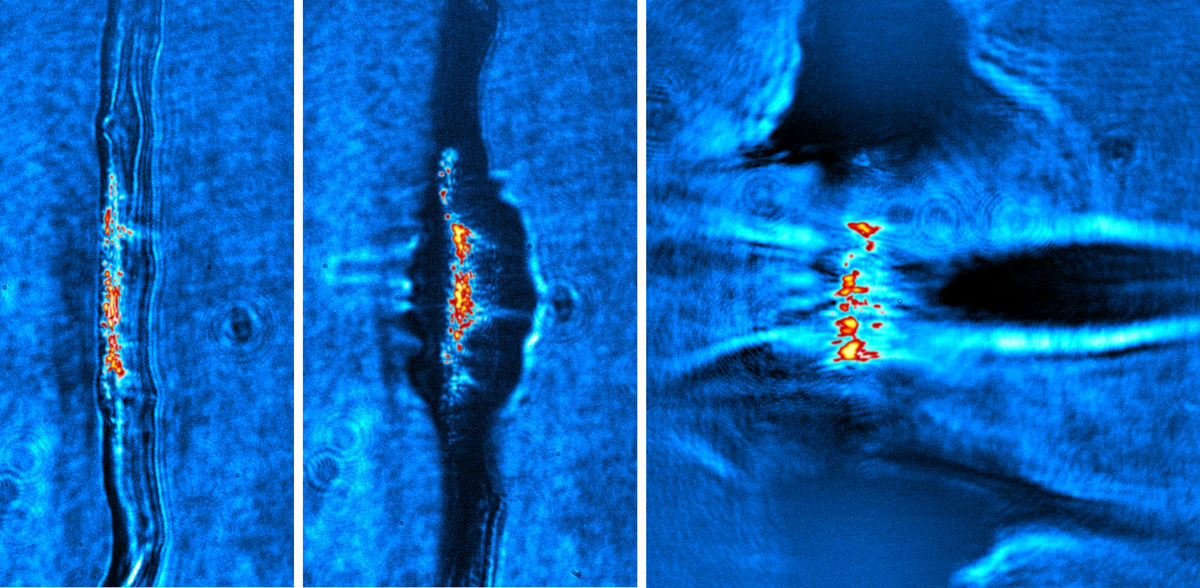Frosty hydrogen as target
New method improves proton acceleration with high power laser
Advertisement
Bringing protons up to speed with strong laser pulses – this still young concept promises many advantages over conventional accelerators. For instance, it seems possible to build much more compact facilities. Prototypes to date, however, in which laser pulses are fired at ultra-thin metal foils, show weaknesses – especially in the frequency with which they can accelerate protons. At the Helmholtz-Zentrum Dresden-Rossendorf (HZDR), an international working group has tested a new technique: In this approach, frozen hydrogen acts as a "target" for the laser pulses. In the future, the method could serve as a basis for advanced tumor therapy concepts, as the team describes in the journal Nature Communications.

Schema of the experimental setup: By shooting an intense pulse (red) from the HZDR high power laser DRACO onto a continuously replenishing frozen hydrogen jet (blue), the researchers were able to massively accelerate protons over an extremely short distance (orange). They recorded the process with a synchronized optical laser pulse (green).
SLAC National Accelerator Laboratory / G. Stewart
Conventional proton accelerators such as the Large Hadron Collider at CERN in Geneva are based on the particle acceleration via strong radio frequency waves. In laser acceleration, on the other hand, ultra-bright light pulses give the particles a boost: Extremely short and powerful laser pulses are fired at wafer-thin metal foils. The light heats the material to such an extent that electrons are ejected in large numbers, while the heavy atomic nuclei remain in place. Since the electrons are negatively charged and the atomic nuclei are positively charged, a strong electric field forms between them.
This field can then launch a pulse of protons with enormous force over a distance of only a few micrometers, thus bringing them to energies for which much longer systems would be needed with conventional accelerator technology. Another advantage: "With laser acceleration, we can pack a huge number of particles into one proton bunch," explains physicist Dr. Karl Zeil of the Institute of Radiation Physics at HZDR. "This could be interesting for radiation therapy of tumors."
However, the previous method of firing laser pulses at metal foils has drawbacks. Firstly, it is difficult to generate several proton pulses per second – the foil is already destroyed by a single laser shot and therefore has to be replaced again and again. Secondly, the acceleration process is quite complex and relatively difficult to control. The reason: The protons to be accelerated come from hydrocarbons that have accumulated on the metal foils as a layer of contaminants – not exactly ideal for perfect control of the experiment.
Filament instead of foil
Therefore, the German-American research team around Karl Zeil came up with an alternative: "Instead of a metal foil, we use a fine, strongly cooled hydrogen jet," the researcher describes. "This jet serves as a target for our high-intensity laser pulses." Specifically, the experts cool hydrogen gas in a copper block to such an extent that it becomes liquid. The liquid hydrogen then flows through a nozzle into a vacuum chamber. It thus cools further and solidifies into a micrometer-thin filament: the target for the laser pulses. And since the hydrogen filament renews itself, the laser has a new, intact target in its sight for every shot.
Another benefit is that the setup allows for a more favorable acceleration mechanism: Instead of just heating the material, the laser pulses use radiation pressure to push the electrons out of the hydrogen and create the extreme electric fields needed to accelerate the protons. The team was able to optimize the process by sending a short, weaker light pulse in front of the main laser pulse. This preheated the frozen hydrogen filament, causing it to expand and its cross-section to grow from five micrometers to several times that size. This made it possible to increase the acceleration distance and optimize the process.
Prospects for tumor therapy
The result: "We were able to bring protons up to an energy of 80 MeV," reports Karl Zeil. "This is close to the previous record for laser proton acceleration. But unlike previous facilities, our technique has the potential to generate multiple proton bunches per second." Furthermore, the acceleration process is comparatively easy to simulate for hydrogen targets using high-performance computing – a task that also involved the Center for Advanced Systems Understanding (CASUS) at HZDR. "This allows us to better understand and optimize the interaction between laser and matter," Zeil said. Now the experts want to use AI algorithms to increase the "hit rate" between the laser pulses and the frozen hydrogen jet.
The technology could be interesting for a future type of radiation therapy. Already today, some tumors are successfully irradiated with protons. Laser acceleration could increase the dose and thus shorten the irradiation time. And – as an HZDR study suggests – this could better protect the healthy tissue surrounding the tumor.
Original publication
M. Rehwald, S. Assenbaum, C. Bernert, F. Brack, M. Bussmann, T. Cowan, C. Curry, F. Fiuza, M. Garten, L. Gaus, M. Gauthier, S. Göde, I. Göthel, S. Glenzer, L. Huang, A. Huebl, J. Kim, T. Kluge, S. Kraft, F. Kroll, J. Metzkes-Ng, et al.: "Ultra-short pulse laser acceleration of protons to 80 MeV from cryogenic hydrogen jets tailored to near-critical density", Nature Communications, 2023.


























































